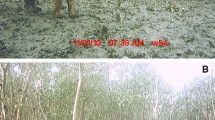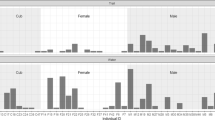Abstract
Historically, the distribution of fishers (Martes pennanti) in North America included portions of eastern North Dakota, USA; however, the population was reported to have become extirpated by the early 1900s. Verified reports, road-killed and incidentally trapped individuals, indicate that fishers have been re-establishing populations in riparian forests (the only areas with substantive forest cover in the region) over the last 10 years. During the summers of 2008 (16 Jun–1 Aug) and 2009 (1 Jun–18 Aug), we conducted presence–absence sampling using remote cameras and enclosed track-plates to determine the distribution of fishers along 237 km of the Red River of the North in North Dakota. Between sampling events, the Red River experienced an extreme flood with peak flooding above major flood stage, which inundated all riparian forests within the study area from approximately 23 Mar–22 May. Because of the severity of the flood, we anticipated that fishers could have perished or been displaced from much of the study area, resulting in lower detection rates in 2009 than 2008. However, fishers were detected throughout the study area during both years and, unexpectedly, detection rates were higher in 2009 than 2008 (28 out of 35 sites [80%] and 25 out of 57 sites [44%], respectively). Our study demonstrates that fishers existing in what traditionally would have been considered marginal habitat for the species were able to persist following a severe, multi-month flood that inundated >95% of the forest habitat.




Similar content being viewed by others
References
Adams AW (1961) Furbearers of North Dakota. North Dakota Game and Fish Department, North Dakota
Allen AW (1983) Habitat suitability index models: fishers. U.S. Fish and Wildlife Service, Colorado
Anderson DC, Wilson KR, Miller MS, Falck M (2000) Movement patterns of riparian small mammals during predictable floodplain inundation. J Mammal 81:1087–1099. doi:10.1644/1545-1542(2000)081<1087:MPORSM>2.0.CO;2
Arthur SM, Krohn WB, Gilbert JR (1989) Habitat use and diet of fishers. J Wildl Manage 53:680–688. doi:10.2307/3809197
Arthur SM, Paragi TF, Krohn WB (1993) Dispersal of juvenile fishers in Maine. J Wildl Manage 54:868–874. doi:10.2307/3809091
Bailey V (1926) A biological survey of North Dakota. USDA Bureau of Biological Survey, North America Fauna, No. 49, Washington
Batzli GO (1977) Population dynamics of the white-footed mouse in floodplain and upland forests. Am Midl Nat 97:18–32. doi:10.2307/2424681
Berg WE, Kuehn DW (1994) Demography and range of fishers and American martens in a changing Minnesota landscape. In: Buskirk SW, Harestad AS, Raphael MG, Powell RA (eds) Martens, sables and fishers: biology and conservation. Cornell University Press, New York, pp 262–271
Blair WF (1939) Some observed effects of stream-valley flooding on mammalian populations in eastern Oklahoma. J Mammal 20:304–306. doi:10.2307/1374253
Bluemle JP (1997) Factors affecting flooding in the Red River Valley. Proc N D Acad Sci 51:17–20
Bolen EG, Robinson WL (2003) Wildlife ecology and management, 5th edn. Pearson Education Incorporated, New Jersey
Buskirk SW, Powell RA (1994) Habitat ecology of fishers and American martens. In: Buskirk SW, Harestad AS, Raphael MG, Powell RA (eds) Martens, sables and fishers: biology and conservation. Cornell University Press, New York, pp 283–296
Coulter MW (1966) Ecology and management of fishers in Maine. Dissertation, State University College of Forestry at Syracuse
Deschamps A, Greenlee D, Pultz TJ, Saper R (2002) Geospatial data integration for applications in flood prediction and management in the Red River Basin. Int Geosci Rem Sens Symp 6:3338–3340
de Vos A (1951) Overflow and dispersal of marten and fisher from wildlife refuges. J Wildl Manage 15:164–175. doi:10.2307/3796605
de Vos A (1952) The ecology and management of fisher and marten in Ontario. Ontario Department of Lands and Forests, Technical Bulletin, Wildlife Service Number 1, Ontario
Douglas CW, Strickland MA (1987) Fisher. In: Novak M, Baker JA, Obbard ME, Mallock B (eds) Wild furbearer management and conservation in North America. Ontario Ministry of Natural Resources, Ontario, pp 511–529
Erb J (2010) Registered furbearer harvest statistics. Forest Wildlife and Populations Research Group, DNR, Minnesota
Forsyth A (1985) Mammals of the American North. Camden House Publ. Ltd., Ontario
Gehrt SD, Fox LB, Spencer DL (1993) Locations of raccoons during flooding in eastern Kansas. Southwest Nat 38:404–406. doi:10.2307/3671630
Hagen SK, Isakson PT, Dyke SR (2005) North Dakota comprehensive wildlife conservation strategy. North Dakota Game and Fish Department, North Dakota
Jain SK, Singh RD, Jain MK, Lohani AK (2005) Delineation of flood-prone areas using remote sensing techniques. Water Resour Manage 19:333–347. doi:10.1007/s11269-005-3281-5
Kelly GM (1977) Fisher (Martes pennanti) biology in the White Mountain National Forest and adjacent areas. Dissertation, University of Massachusetts
Klein DR (1968) The introduction, increase, and crash of reindeer on St. Matthew Island. J Wildl Manage 32:350–367. doi:10.2307/3798981
Koel TM, Peterka JJ (1998) Stream fishes of the Red River of the North Basin, United States: a comprehensive review. Can Field-Nat 112:631–646
Loughry, SC (2010) Assessing the natural history and habitat use of the fisher in eastern North Dakota. Thesis, Frostburg State University
McCarley H (1959) The effect of flooding on a marked population of Peromyscus. J Mammal 40:57–63. doi:10.2307/1376442
McFeeters SK (1996) The use of the Normalized Difference Water Index (NDWI) in the delineation of open water features. Int J Remote Sens 17:1425–1432. doi:10.1080/01431169608948714
National Weather Service (2010) Definitions and general terminology. Manual 10-950. Available at http://www.nws.noaa.gov/directives. Accessed 20 November 2010
Powell RA (1993) The fisher: life history, ecology and behavior, 2nd edn. University of Minnesota Press, Minnesota
Renard PA, Hanson SR, Enblom JW (1986) Biological survey of the Red River of the North. Minnesota Department of Natural Resources, Special Publication #142, Minnesota
Samuel WM, Glazener WC (1970) Movement of white-tailed deer fawns in south Texas. J Wildl Manage 34:959–961. doi:10.2307/3799171
Sovada MA, Seabloom R (2005) Wild mammals of North Dakota: species accounts and management guidelines. U.S. Geological Survey, North Dakota
Stickel LF (1948) Observations on the effect of flood on animals. Ecology 29:505–507. doi:10.2307/1932643
Strickland MA, Douglas CW, Novak M, Hunziger NP (1982) Fisher. In: Chapman JA, Feldhamer GA (eds) Wild mammals of North America: biology, management and economics. John Hopkins University Press, Maryland, pp 586–598
Triska MD (2010) Assessing the current and projected future distribution of a recently re-populating fisher (Martes pennanti) population in eastern North Dakota. Thesis, Frostburg State University
United States Geological Survey (2007) A history of flooding in the Red River Basin. U.S. Geological Survey General Information Product, Report: GIP 0055. Available at http://pubs.usgs.gov/gip/2007/55. Accessed 15 February 2010
Wijnhoven S, van der Velde G, Leuven RSEW, Smits AJM (2006) Modelling recolonisation of heterogeneous river floodplains by small mammals. Hydrobiologia 565:135–152. doi:10.1007/s10750-005-1910-x
Williams AK, Ratnaswamy MJ, Renken RB (2001) Impacts of a flood on small mammal populations of the lower Missouri River floodplain forests. Am Midl Nat 146:217–221. doi:10.1674/0003-0031(2001)146[0217:IOAFOS]2.0.CO;2
Yeager LE, Anderson HG (1944) Some effects of flooding and waterfowl concentration on mammals of a refuge area in central Illinois. Am Midl Nat 31:159–178. doi:10.2307/2421388
Zielinski WJ, Kucera TE (1995) Introduction to detection and survey methods. In: Zielinski WJ, Kucera TE (eds) American marten, fisher, lynx and wolverine: survey methods for their detection. USDA Forest Service, Pacific Southwest Research Station, California, pp 1–15
Zielinski WJ, Truex RL, Schmidt GA, Schelexer FV, Schmidt KN, Barrett RH (2004) Home range characteristics of fishers in California. J Mammal 85:649–657. doi:10.1644/BOS-126
Acknowledgements
Financial support for this project was provided by Wildlife and Sport Fish Restoration funds under the State Wildlife Grants program (CFDA 15.634), which are administered by the North Dakota Game and Fish Department, the Wilson H. Elkins Professorship of the University of Maryland, and the Department of Biology at Frostburg State University. We are grateful to guidance and assistance provided by D. Fecske, S. Dyke, S. Johnson, P. Isakson, C. Penner, G. Rankin, B. Hosek, D. Casady, and the North Dakota Game and Fish Department. We would also like to thank the numerous North Dakota landowners that granted us land access, North Dakota Parks and Recreation for housing, M. Ramspott for remote sensing help, and S. Peper for field assistance.
Ethical standards
This study was complied with all USA and international laws.
Conflict of interest
The authors do not have any conflict of interest. All funding sources are declared in the “Acknowledgements”.
Author information
Authors and Affiliations
Corresponding author
Additional information
Communicated by: Andrzej Zalewski
Rights and permissions
About this article
Cite this article
Triska, M.D., Loughry, S.C. & Serfass, T.L. Persistence of fishers in riparian forests in North Dakota, USA following a severe flood event. Acta Theriol 56, 367–374 (2011). https://doi.org/10.1007/s13364-011-0028-y
Received:
Accepted:
Published:
Issue Date:
DOI: https://doi.org/10.1007/s13364-011-0028-y




